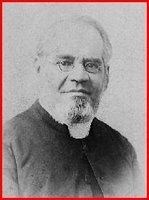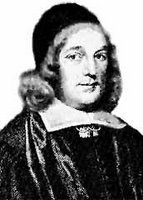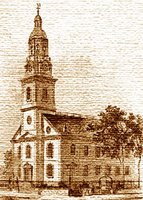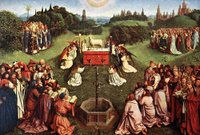
During the summer, while doing research for an article, I happened to find an autobiography of one of the individuals who preached in England during the revival which swept the British Isles in the late 1850s and early 1860s. From Death Into Life is the story of William Haslam (1818-1905), an English country parson who, in 1851, was converted during the preaching of a sermon on the topic of conversion. The unusual aspect of this is that the sermon was preached by William Haslam himself. The evidence of his changed heart and mind during that sermon was so obvious that a Methodist preacher in attendance at the service began to cry out "The Parson is converted!"
I wanted to include a brief section of Chapter 34 of the book as it is a meditation on the text of Numbers 21:5-9:
The people spoke against God and Moses, "Why have you brought us up out of Egypt to die in the wilderness? For there is no food and no water, and we loathe this miserable food." The LORD sent fiery serpents among the people and they bit the people, so that many people of Israel died. So the people came to Moses and said, "We have sinned, because we have spoken against the LORD and you; intercede with the LORD, that He may remove the serpents from us." And Moses interceded for the people. Then the LORD said to Moses, "Make a fiery serpent, and set it on a standard; and it shall come about, that everyone who is bitten, when he looks at it, he will live." And Moses made a bronze serpent and set it on the standard; and it came about, that if a serpent bit any man, when he looked to the bronze serpent, he lived.
Numbers 21:5-9 NASB
Recounting an incident just prior to his departure from Hayle, St. Johns, Haslam reflected:
A few weeks before leaving Hayle, as I was sitting by the fire one wet afternoon, my eyes fell on a little coloured picture on the mantle-piece, which had been the companion of my journeys for all the twenty years of which I have been writing. It was a quaint mediaeval illustration of Moses lifting up the serpent in the wilderness, copied from a valuable manuscript (Book of Prayers) in the Bodleian Library at Oxford.
As I looked at the engraving before me, I began to suspect for the first time that there was a design in the arrangement of the figures, and that it was really intended to convey some particular teaching. I took it in my hand and studied it, when I observed that the cross or pole on which the serpent was elevated stood in the centre, dividing two sets of characters, and that there were serpents on one side, and none on the other.
Behind the figure of Moses, is a man standing with his arms crossed on his breast, looking at the brazen serpent. He has evidently obtained life and healing by a look. On the other side, I observed that there were four kinds of persons represented, who were not doing as this healed one did to obtain deliverance.
First, there is one who is kneeling in front of the cross, but he is looking towards Moses, and not at the serpent, and apparently confessing to him as if he were a priest.
Next behind him is one lying on his back, as if he was perfectly safe,though he is evidently in the midst of danger; for a serpent may be seen at his ear, possibly whispering "Peace, peace, when there is no peace."
Still further back from the cross there is a man with a sad face doing a work of mercy, binding up the wounds of a fellow-sufferer, and little suspecting that he himself is involved in the same danger.
Behind them all, on the background, is a valiant man who is doing battle with the serpents, which may be seen rising against him in unabating persistency.
I observed that none of these men were looking at the brazen serpent as they were commanded to do. I cannot describe how excited and interested I became; for I saw in this illustration a picture of my own life. Here was the way of salvation clearly set forth, and four ways which are not the way of salvation, all of which I had tried and found unavailing. This was the silent but speaking testimony of some unknown denizen of a cloister, who lived in the beginning of the fifteenth century, in the days of ignorance and superstition. But not withstanding this darkness,he was brought out into the marvellous light of the Gospel, and has left this interesting record of his experience.
Like him, I also had fought with serpents, for I began in my own strength to combat with sin, and strove by my own resolutions to overcome. From this, I went on to do good works, and works of mercy, in the vain hope of thus obtaining the same for myself. Then, I relied in the Church for salvation, as God's appointed ark of safety; but not feeling secure, I took another step beyond, and sought forgiveness through the power of the priest. This I found was as ineffectual as all my previous efforts. At last, I was brought (by the Spirit of God) as a wounded and dying sinner, to look at the Crucified One. Then (as I have related), I found pardon and peace. Ever since it has been my joy and privilege (like Moses pointing to the serpent) to cry, "Behold the Lamb of God which taketh away the sin of the world" (John 1:29). "I have determined to know nothing but Jesus Christ and Him crucified;" that is, to tell only of the person and office of Jesus Christ our Lord.
As you may have guessed, the photograph above is that of William Haslam.
 In our life of prayer, it is natural that prayer should well up from within us and be expressed in our own words. It is a mark of the conversational aspect of prayer from us to our heavenly Father. Our experiences in prayer may be such that this is the only form of prayer which we have so far encountered.
In our life of prayer, it is natural that prayer should well up from within us and be expressed in our own words. It is a mark of the conversational aspect of prayer from us to our heavenly Father. Our experiences in prayer may be such that this is the only form of prayer which we have so far encountered.








